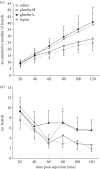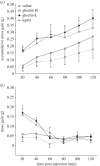Peripherally injected ghrelin and leptin reduce food hoarding and mass gain in the coal tit (Periparus ater)
- PMID: 29794047
- PMCID: PMC5998117
- DOI: 10.1098/rspb.2018.0417
Peripherally injected ghrelin and leptin reduce food hoarding and mass gain in the coal tit (Periparus ater)
Abstract
In birds little is known about the hormonal signals that communicate nutritional state to the brain and regulate appetitive behaviours. In mammals, the peptide hormones ghrelin and leptin elevate and inhibit consumption and food hoarding, respectively. But in birds, administration of both ghrelin and leptin inhibit food consumption. The role of these hormones in the regulation of food hoarding in avian species has not been examined. To investigate this, we injected wild caught coal tits (Periparus ater) with leptin, high-dose ghrelin, low-dose ghrelin and a saline control in the laboratory. We then measured food hoarding and mass gain, as a proxy of food consumption, every 20 min for 2 h post-injection. Both high-dose ghrelin and leptin injections significantly reduced hoarding and mass gain compared with controls. Our results provide the first evidence that hoarding behaviour can be reduced by both leptin and ghrelin in a wild bird. These findings add to evidence that the hormonal control of food consumption and hoarding in avian species differs from that in mammals. Food hoarding and consumptive behaviours consistently show the same response to peripheral signals of nutritional state, suggesting that the hormonal regulation of food hoarding has evolved from the consumption regulatory system.
Keywords: caching; energy management; food intake; hormones.
© 2018 The Author(s).
Conflict of interest statement
We declare we have no competing interests.
Figures


Similar articles
-
Effects of ghrelin on food caching behaviour and body composition in black-capped chickadees (Poecile atricapillus).Gen Comp Endocrinol. 2024 May 15;351:114475. doi: 10.1016/j.ygcen.2024.114475. Epub 2024 Feb 19. Gen Comp Endocrinol. 2024. PMID: 38382621
-
AgRP knockdown blocks long-term appetitive, but not consummatory, feeding behaviors in Siberian hamsters.Physiol Behav. 2018 Jun 1;190:61-70. doi: 10.1016/j.physbeh.2017.10.008. Epub 2017 Oct 12. Physiol Behav. 2018. PMID: 29031552 Free PMC article.
-
Central ghrelin increases food foraging/hoarding that is blocked by GHSR antagonism and attenuates hypothalamic paraventricular nucleus neuronal activation.Am J Physiol Regul Integr Comp Physiol. 2016 Feb 1;310(3):R275-85. doi: 10.1152/ajpregu.00216.2015. Epub 2015 Nov 11. Am J Physiol Regul Integr Comp Physiol. 2016. PMID: 26561646 Free PMC article.
-
Neural and hormonal control of food hoarding.Am J Physiol Regul Integr Comp Physiol. 2011 Sep;301(3):R641-55. doi: 10.1152/ajpregu.00137.2011. Epub 2011 Jun 8. Am J Physiol Regul Integr Comp Physiol. 2011. PMID: 21653877 Free PMC article. Review.
-
Physiological mechanisms for food-hoarding motivation in animals.Philos Trans R Soc Lond B Biol Sci. 2010 Mar 27;365(1542):961-75. doi: 10.1098/rstb.2009.0225. Philos Trans R Soc Lond B Biol Sci. 2010. PMID: 20156819 Free PMC article. Review.
Cited by
-
Leptin administration does not influence migratory behaviour in white-throated sparrows (Zonotrichia albicollis).PeerJ. 2022 Jun 15;10:e13584. doi: 10.7717/peerj.13584. eCollection 2022. PeerJ. 2022. PMID: 35726262 Free PMC article.
-
Modulation of angiogenesis by topical application of leptin and high and low molecular heparin using the Japanese quail chorioallantoic membrane model.Saudi J Biol Sci. 2020 Jun;27(6):1488-1493. doi: 10.1016/j.sjbs.2020.04.013. Epub 2020 Apr 20. Saudi J Biol Sci. 2020. PMID: 32489285 Free PMC article.
-
The unexpected loss of the 'hunger hormone' ghrelin in true passerines: a game changer in migration physiology.R Soc Open Sci. 2025 Mar 19;12(3):242107. doi: 10.1098/rsos.242107. eCollection 2025 Mar. R Soc Open Sci. 2025. PMID: 40109942 Free PMC article.
-
A first glimpse into circulating ghrelin patterns of thin-billed prion chicks (Pachyptila belcheri).J Comp Physiol B. 2025 Apr;195(2):209-213. doi: 10.1007/s00360-025-01602-7. Epub 2025 Feb 14. J Comp Physiol B. 2025. PMID: 39953262 Free PMC article.
-
Form and Function of the Vertebrate and Invertebrate Blood-Brain Barriers.Int J Mol Sci. 2021 Nov 9;22(22):12111. doi: 10.3390/ijms222212111. Int J Mol Sci. 2021. PMID: 34829989 Free PMC article. Review.
References
-
- Vander Wall SB. 1990. Food hoarding in animals. Chicago, IL: Chicago University Press.
Publication types
MeSH terms
Substances
Associated data
LinkOut - more resources
Full Text Sources
Other Literature Sources

